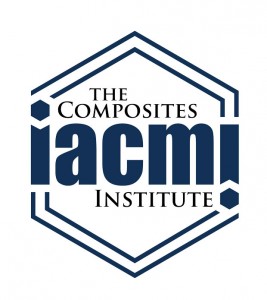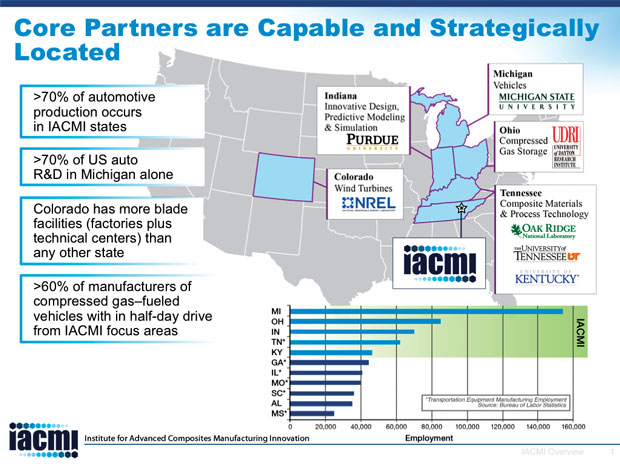IACMI Advances Engineering of Composites

Latest News
October 1, 2015
 As technology advances, engineers keep finding ways to make products that are lighter, faster, cheaper and smarter. These goals can be achieved in a variety of ways, including the use of advanced materials. By using new materials, design teams can meet requirements for sustainability and lightweighting that affect a number of industries. To do so, the materials themselves need to be researched, simulated, tested and manufactured.
As technology advances, engineers keep finding ways to make products that are lighter, faster, cheaper and smarter. These goals can be achieved in a variety of ways, including the use of advanced materials. By using new materials, design teams can meet requirements for sustainability and lightweighting that affect a number of industries. To do so, the materials themselves need to be researched, simulated, tested and manufactured.
To advance research, development and data for composite materials, the Institute for Advanced Composites Manufacturing Innovation (IACMI) was formed as part of the National Network for Manufacturing Innovation and in partnership with the Department of Energy. IACMI is a group of academic, research and industry giants who are not only helping expand the application of polymer matrix composite materials, but also the adoption of new manufacturing technologies.
The institute officially launched this year, but a lot of its member organizations have been working with the composite industry for decades, says Craig Blue, CEO of IACMI. “There’s a small group of people that came together from the Oak Ridge National Laboratory and University of Tennessee,” he says. “Through our interactions with industry and the DOE’s request for information, [it became clear] they needed capabilities and infrastructure in terms of R&D scale-up, and they wanted it in their backyard.”
Membership, Projects and Initiatives
The initiative is currently made up of 57 committed private companies, 15 universities and laboratories, 26 consortia members, and 14 additional entities—and that number is growing. Spanning the United States, IACMI is focusing its work in five main areas: vehicles, wind, compressed gas storage, design and simulation, as well as composite materials and processes. Concentrated areas of research are located in Michigan, Colorado, Ohio, Indiana, Kentucky and Tennessee. In these regions, networks of collaboration have been established with local companies, universities, community colleges and research labs.“The vast majority of projects within the institute will be industry-led projects,” says Blue. “Clearly industry knows where there challenges are [with composites], and we’re going to work side-by-side with them to address those challenges and let them gain access to research, scientists, engineers and facilities.” By having this involvement, it not only gives IACMI a realistic idea of how their work can better help engineers in the field, but also expands the capabilities of companies to integrate composites within products.
Furthermore, the institute is offering a variety of ways for interested organizations to get involved. Not only are there a host of different membership levels, but interested organizations can submit applications for research, design and development projects—from enterprise level (large multi-disciplinary, multi-year projects) to smaller technical initiatives.
Taking Composites to a National Level
To gain optimal resources, accessibility and impact, the IACMI is a national initiative. By having a national footprint and companion technology area expertise, it is able to reach industry where it is most concentrated. Creating collaborations with companies that are located near industry epicenters fosters more direct adoption of research and manufacturing methods.
“Industry does not reside in one location: A lot of the innovation happens in the supply chain and proximity to those companies matters. There’s a general movement [where companies are] putting R&D close to their manufacturing. Having one location, while that’s good, this initiative is bigger than one location. We’re trying to maximize our resources,” says Blue.
When forming this more centralized network of manufacturing innovation, IACMI decided that it should “go to where there’s existing infrastructure, [because] we don’t want to take federal or private funds and reproduce existing capabilities,” Blue says. “But we have to have the space where we can do research that’s more open and still protects the IP (intellectual property).”
IACMI is working to achieve both technical and industry goals. From a technical viewpoint, the IACMI hopes to:
• Reduce the cost of carbon-fiber reinforced polymers (CFRP) by 25%
• Reduce energy consumption required for production of CRFP by 50%
• Attain 80% composite recyclability into useful products
But IACMI isn’t solely focusing on CRFP—it also includes glass-fiber reinforced composites in its research.
By focusing on these technical goals, the institute not only helps produce more effective composites, but it can also ensure there is technology to manufacture these materials quickly, sustainably and at a reduced cost.
In addition to giving industry more direct access to composite data and material, IACMI is also involved in helping grow local economies and manufacturing initiatives. Goals include increasing domestic production capacity and local job growth. According to Blue, IACMI looked to local and state governments to help with economic initiatives and promote economic sustainability.
Extending the Reach of Composites
Integrating composites into a product can yield benefits such as increased strength with lighter weight. But the adoption of these materials for a large-scale manufacturing environment poses two main challenges: time and cost. Even if organizations do have the technology to produce composites, the currently available materials often come at a greater cost in the supply chain and slower production rates, according to Blue.
With current standards, composites are utilized in a handful of consumer products, but are usually used on a small production scale. “Composites are commercial today for typically low-volume applications. And there’s a real push to commoditize composites. So we want to look at large platforms,” Blue says.
But the availability of low-volume production is serving as a launch pad for the institute. By being able to see what current technologies and applications are available, IACMI can evaluate where innovation and improvements are needed. “Typically when people think of composites, they think of high-end—like aerospace, niche automotive for high-end cars, low volume [production], and we want to enable composites for the consumer vehicle. We want to make sure [the IACMI] can extend the extensive compositing that already goes on,” Blue says.
 To help industry where it is most prevalent, IACMI established research centers in the top states for automotive, wind and compressed gas. Additional partners are located in close proximity to national research labs and manufacturing centers. Image courtesy of IACMI.
To help industry where it is most prevalent, IACMI established research centers in the top states for automotive, wind and compressed gas. Additional partners are located in close proximity to national research labs and manufacturing centers. Image courtesy of IACMI.Covering the Entire Design Process
In addition to spanning multiple industries, IACMI isn’t specializing in just one area of composite production. To address innovation on several levels, teams are also helping develop both composite-specific simulation software and manufacturing methods to create solutions for the entire design-to-production process.
At Purdue University, researchers are working to create the Composites Virtual Factory HUB (cvfHUB), a portfolio of commercial tools from companies such as Altair, Dassault Systèmes, MSC Software and ESI Group to aid composite design and manufacturing simulation. The Web-based program is being developed to support simulation and validation of composites and processes being used at other IACMI sites. With the cvfHUB, users will eventually be able to use the platform for end-to-end simulation in multiple industries and various levels: from lab-scale to full-scale validation.
Located near IACMI’s headquarters in Tennessee, the Composite Materials and Processing Technology area is focusing on materials and processing. Here, local universities and partners are investigating physical material properties and generating production systems for resins, plastics and polymers that are more energy efficient and cost-effective. “Initially, we’ll be looking at processing speeds of three minutes, driving it down to within a minute for processing speeds,” says Blue. The technology area, led by ORNL with support from the University of Tennessee and the University of Kentucky, currently has systems for spinning, melt spinning, bench and pilot scale heat treatment, compounding, thermoforming and more.
Beyond the production of materials, researchers in Tennessee are focusing on increasing recyclability of composite materials. In ensuring these materials have the potential for reuse, it reduces the amount of debris produced while promoting sustainability.
Building a Future
Even with its current member base, Blue says there are plans to grow the number of involved organizations—from industry to state government. In doing so, IACMI can not only increase access to composites and associated research, the institute can also help promote manufacturing initiatives across the nation. This expansive, collaborative institute will not only help organizations gain more knowledge of composite materials and production processes, but also help ensure engineering teams can implement them effectively, efficiently and sustainably.
More Info
Subscribe to our FREE magazine, FREE email newsletters or both!
Latest News
About the Author
Jess Lulka is a former associate editor for Digital Engineering. Contact her via [email protected].
Follow DE





